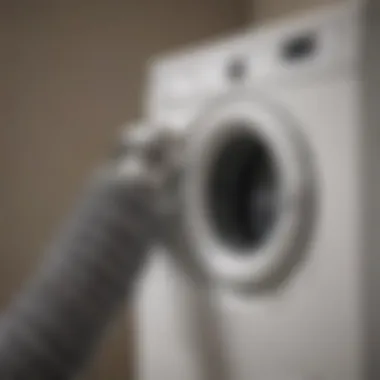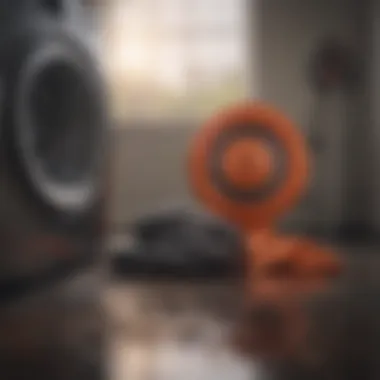Effective Air Hose Attachments for Dryer Vent Cleaning


Intro
Maintaining a dryer vent is essential to ensure its optimal performance and longevity. Dryer vent systems can accumulate lint and debris over time. This increases the risk of fire and reduces the efficiency of the appliance. An air hose attachment designed for dryer vent cleaning is a practical solution. It facilitates effective removal of buildup from hard-to-reach areas.
This guide aims to explore the functions, advantages, and different kinds of air hose attachments used for cleaning dryer vents. Thorough understanding of these tools can enhance safety in homes and improve ventilation systems, making them more effective.
Importance of Proper Vent Maintenance
Regular maintenance of dryer vents plays a crucial role in household safety and appliance efficiency. Clogged vents can lead to increased drying times and higher energy bills. It is also possible for lint buildup to become a significant fire hazard.
Benefits of Regular Cleaning
- Improved Airflow: Removing lint ensures proper airflow through the vent.
- Energy Efficiency: Clean vents lead to faster drying times, which saves energy.
- Fire Prevention: A clean vent drastically reduces the risk of fire hazards.
- Extended Appliance Life: Consistent maintenance can prolong the lifespan of the dryer.
By adopting routine cleaning practices, one can avoid many potential problems associated with dryer vent clogs.
Regular cleaning of dryer vents can't be stressed enough. It's not just about efficiency but safety as well.
Functionality of Air Hose Attachments
Air hose attachments are designed to facilitate the cleaning process. They work by connecting to a standard air compressor, allowing strong bursts of air to dislodge lint and debris. The effectiveness of these tools is dependent on their design and how they are employed during cleaning.
Types of Air Hose Attachments
- Rigid Attachments: These provide precise control and can reach specific areas within the vent.
- Flexible Hose Attachments: Ideal for navigating bends and curves in venting systems, making them versatile.
- Specialized Brushes: Some attachments come with built-in brushes to further agitate lint.
Selecting the right attachment is paramount to ensure proper cleaning without damaging the vent.
Safety Measures
When cleaning dryer vents, safety should be a top priority. Always wear protective goggles and a mask to prevent inhalation of dust and debris. Unplugging the dryer before starting any cleaning activities is crucial.
Additional Safety Tips
- Regularly inspect the electrical components of the dryer.
- Ensure that the venting duct is made of appropriate materials that are less likely to trap lint.
By prioritizing these safety practices, individuals can minimize risks involved with dryer vent maintenance.
The End
In summary, air hose attachments are an invaluable tool for maintaining dryer vents. Understanding the importance of these devices in enhancing appliance performance and ensuring household safety is critical. Regular cleaning can offer numerous benefits, from savings on energy costs to preventing potential hazards. Homeowners and professionals alike should be well-informed on how to use these attachments effectively.
Understanding the Importance of Dryer Vent Maintenance
Maintaining dryer vents is crucial for numerous reasons, ranging from safety to efficiency. Failing to attend to this maintenance results in various detrimental consequences, which underscores the significance of understanding proper practices in vent upkeep. Homeowners and cleaning professionals alike must recognize how neglected vents can lead to hazardous situations. Moreover, they should appreciate how regular cleaning substantially elevates the effectiveness of appliances.
Consequences of Neglected Dryer Vents
Neglecting dryer vent maintenance can lead to serious issues. Clogged vents are a major fire risk. Lint buildup restricts airflow, causing the dryer to overheat, potentially igniting any flammable materials. Beyond being a safety hazard, these blockages hinder the dryer’s efficiency. When airflow is restricted, the dryer works harder and longer to dry clothes. This can significantly increase energy consumption, resulting in higher utility bills. Furthermore, prolonged use of a poorly maintained dryer can lead to mechanical failures, which require costly repairs or replacements.
Benefits of Regular Cleaning
Regular cleaning of dryer vents presents numerous advantages. First, it minimizes the risk of fire. By keeping vents clear, homeowners create a safer environment. Additionally, clean vents optimize dryer efficiency. Improved airflow means the dryer operates effectively, reducing drying times and energy costs. A well-maintained dryer extends its lifespan. This maintenance mitigates wear and tear, ultimately prolonging the appliance's functionality. Regular cleaning also contributes to better indoor air quality by preventing mold and mildew growth, which can flourish when moisture is trapped in the ducts.
In summary, understanding the importance of dryer vent maintenance is essential. It is not just about saving time or money; it is also about ensuring safety and creating a more efficient home environment.
Prolusion to Air Hose Attachments
Understanding air hose attachments is crucial for effective dryer vent maintenance. These tools enhance the efficiency of cleaning processes, ensuring that vents operate at peak performance. When dryer vents are clean, dryers work more efficiently, leading to improved energy savings and reduced wear on the appliance. Furthermore, effective vent cleaning can also prevent hazardous situations like fire risks associated with lint build-up.
What is an Air Hose Attachment?
An air hose attachment is a specialized tool designed for connecting to a vacuum or blower to clean dryer vents. It typically features a flexible hose that can reach into narrow or obstructed spaces that standard cleaning equipment cannot access. These attachments come in various sizes and shapes, each designed for specific tasks related to dryer vent cleaning. Proper usage of an air hose attachment can significantly enhance the cleaning capability, reaching deep into the ducts to remove accumulated lint and debris. This ensures not only the cleanliness of the vent but also the longevity of the dryer.
Common Use Cases
Air hose attachments are versatile, with multiple applications in dryer vent maintenance. Here are a few common use cases:
- Residential Cleaning: Homeowners often use these attachments to perform routine maintenance on their dryers, ensuring that the vents are clear from any build-up.
- Professional Services: Many cleaning services incorporate air hose attachments into their offerings for thorough dryer vent cleanings. This allows them to provide more effective results compared to conventional methods.
- Custom Applications: Some users customize attachments for specific tasks, such as cleaning other appliances or systems requiring precise air flow.
Key Features of Effective Air Hose Attachments
Understanding the key features of air hose attachments is essential for ensuring their effectiveness in dryer vent cleaning. These features not only enhance the cleaning process but also increase user comfort and efficacy. Homeowners and professionals alike should consider the specific qualities that make one air hose attachment more suitable than another. Key elements such as material, compatibility with cleaning equipment, and flexibility are vital for maximizing cleaning outcomes.
Material and Durability


The material used in air hose attachments directly impacts their durability and effectiveness. Generally, high-quality materials like high-density plastics or reinforced rubber are recommended. These materials withstand wear and tear better than cheaper alternatives.
Benefits of Durable Materials:
- Resistance to Damage: High-quality materials resist chipping, cracking, or bending under stress.
- Longer Lifespan: Durable attachments last longer, reducing replacement costs over time.
- Performance Stability: Sturdy materials maintain performance standards, ensuring consistent airflow and effectiveness during cleaning.
It is wise to assess the attachment's build quality before use. Consider factors such as thickness and overall design while selecting an air hose attachment for your dryer vent cleaning needs.
Compatibility with Cleaning Equipment
An effective air hose attachment must be compatible with the specific cleaning equipment in use. Compatibility ensures that the attachment fits properly with various vacuum systems and tools. Misalignments can lead to reduced suction or airflow, resulting in ineffective cleaning.
Key Considerations for Compatibility:
- Connection Types: Check if the attachment connects seamlessly with your equipment. Common types include standard hose fitting sizes or specific thread types.
- Adaptability: Some attachments come with adapters that allow them to fit different cleaning setups. This is particularly useful for homeowners with various tools.
- Manufacturer Specifications: Always consult the manufacturer’s guidelines to ensure that the attachment matches the requirements of your cleaning system.
Flexible Design for Accessibility
Flexibility in design is another critical feature for air hose attachments, especially when dealing with tight spaces often found in dryer vents. A flexible attachment enables users to navigate corners and angles effectively, reaching areas that might otherwise be difficult to clean.
Advantages of Flexible Design:
- Improved Reach: Flexible attachments can bend and maneuver to access hard-to-reach spots.
- User-Friendly: A flexible design reduces strain on the user’s body while cleaning, making the task less cumbersome.
- Versatile Use: These attachments can be useful for other cleaning tasks beyond dryer vent maintenance, providing added value to the user.
In summary, focusing on material and durability, compatibility with cleaning equipment, and flexibility is essential for selecting effective air hose attachments. These factors contribute significantly to the overall efficiency and ease of dryer vent cleaning.
Types of Air Hose Attachments
Understanding the types of air hose attachments is crucial for anyone involved in dryer vent cleaning. Each attachment serves a unique purpose, contributing to the overall efficiency and effectiveness of the cleaning process. The right type of attachment can determine how thoroughly debris is removed, which directly affects the safety and functionality of the dryer system.
Using the correct attachment can also reduce the time necessary for cleaning, translating to cost savings. For professionals and DIYers alike, knowing the options available is essential for optimal performance during cleaning sessions.
Standard Air Hose Attachments
Standard air hose attachments are often the most commonly used in dryer vent maintenance. These attachments typically come in a variety of sizes and styles, which allows them to fit most standard air hose fittings. One of their main advantages is ease of use; they can connect directly to high-powered blowers or vacuums without any need for special adapters.
Some standard attachments include:
- Nozzle Extensions: These help reach deep into vents, ensuring comprehensive cleaning.
- Flat Nozzles: Ideal for spreading airflow over a wider area, they help dislodge debris.
- Curved Attachments: These allow for pivoting into tight corners, optimizing coverage.
The material used in these standard attachments is often durable plastic or metal, making them capable of withstanding regular usage. They should be chosen based on their compatibility with specific cleaning equipment, ensuring a tight fit to avoid air leaks during operation.
Specialized Attachments
Specialized air hose attachments cater to unique cleaning situations. These tools are designed with specific features to tackle particular challenges within dryer vents. For instance, the shape or flexibility of a specialized attachment may be crucial in navigating intricate ductwork.
Examples of specialized attachments include:
- Flexi-hose Attachments: These can bend and twist, making them suitable for complicated vent paths.
- Brush Attachments: Some tools come equipped with brushes that help dislodge stuck lint and other debris.
- Camera Attachments: These allow the user to visually inspect the duct system, identifying areas that require more intensive cleaning.
Specialized attachments are particularly beneficial for those who deal with older systems or those with a history of buildup. Choosing the appropriate attachment based on your specific cleaning needs can lead to a noticeable increase in cleaning efficiency and safety.
Proper selection of attachments not only enhances cleaning effectiveness but also prolongs the life of your dryer by preventing potential malfunctions due to lint buildup.
Guidelines for Using Air Hose Attachments
Using air hose attachments for dryer vent cleaning is a practical approach that enhances efficiency. This section lays out crucial guidelines to ensure the process is safe and effective. By following these guidelines, users can maximize the benefits of their air hose attachments while minimizing potential hazards.
Preparation for Cleaning
Before beginning any cleaning process, preparation is key. The initial steps include determining the right tools and ensuring that the work area is organized.
- Gathering Necessary Tools: Obtain the air hose attachment that aligns with the cleaning requirements. Check if your vacuum or blower is compatible with the attachment. Additionally, have cleaning solutions and brushes ready for comprehensive cleaning.
- Clearing the Area: Remove any nearby items to create a safe workspace. Ensure that there are no flammable substances around to prevent hazards during the cleaning phase.
- Checking Equipment: Inspect the air hose for any damage or blockages. Ensuring it is in good condition will facilitate smoother operation and prevent accidents. If any wear is noted, consider replacing the part before proceeding.
Proper preparation reduces risks. It also enhances productivity, leading to more effective cleaning outcomes.
Step-by-Step Usage Instructions
When using air hose attachments, a systematic approach helps achieve thorough cleaning. Follow these straightforward steps to ensure optimal results:
- Connect the Attachment: Securely attach the air hose to the cleaning equipment, making sure it fits tightly to avoid any air leaks.
- Position the Equipment: Place the vacuum or blower near the dryer vent for easy access. Ensure the air hose is not twisted or pinched during this step.
- Start the Equipment: Turn on the vacuum or blower, allowing the air to flow through the attachment. Make sure the device is operating correctly before starting the cleaning.
- Insert the Attachment into the Vent: Carefully insert the air hose attachment into the dryer vent, pushing it gently to avoid damaging the vent.
- Move the Attachment: With the air flowing, slowly move the attachment within the vent. Focus on areas that appear particularly clogged or dirty. Keep the motion steady to ensure effective cleaning.
- Check Results Periodically: After a few passes, pull the attachment out to evaluate the debris collected. If necessary, repeat the process until the interior appears clean.
- Finalize the Cleanup: Once satisfied with the cleaning results, turn off the equipment. Disconnect the attachment and store it properly to maintain its durability.
- Inspect the Vent: After cleaning, do a quick inspection of the dryer vent for any remaining debris or potential issues.
By adhering to these guidelines and instructions, users can significantly improve vent cleaning's effectiveness, ensuring their dryer operates at optimal performance.
Safety Precautions


Maintaining safety is a crucial facet of any cleaning task, particularly when dealing with air hose attachments for dryer vent cleaning. Awareness of potential hazards and proper use of protective gear can significantly reduce risks. Safety precautions not only protect the user during operation but also ensure effectiveness in cleaning. Therefore, understanding specific elements and benefits of safety measures is essential for homeowners and cleaning professionals alike.
Essential Protective Gear
When cleaning dryer vents, certain protective gear should not be overlooked. The right equipment ensures safety, helping to prevent injuries or health issues associated with dust, debris, and potential allergens. Here are some essential items:
- Safety Goggles: To protect the eyes from flying debris when the attachment is in use.
- Mask or Respirator: Wearing a respiratory mask can help in filtering out dust particles and allergens, contributing to better respiratory health.
- Gloves: Durable gloves prevent skin irritation and provide grip when handling attachments.
- Knee Pads: If you kneel during operation, knee pads can provide comfort and protect your knees.
Having the correct gear makes a notable difference in the safety and comfort of the cleaning process. Non-compliance can lead to injuries, which could outweigh the benefits of a clean dryer vent.
Awareness of Surrounding Hazards
While using air hose attachments, being mindful of the surrounding environment is equally important. Different hazards can present themselves, and awareness can mitigate risks. Here are some common surrounding hazards to consider:
- Electrical Hazards: Always ensure that the dryer or the power outlet is turned off to avoid electrical shocks while cleaning.
- Ladder Safety: If you need to use a ladder to access the dryer vent, ensure it is stable and avoid reaching too far to maintain balance.
- Obstructions: Remove any items nearby that might cause trips or falls, including hoses, laundry baskets, or tools.
- Vent Temperature: Be aware of the heat from the dryer vent. If it has been in use, it can be hot, which poses a burn risk.
Being aware of these hazards helps users maintain safety while ensuring the vent cleaning process is efficient and effective. Regular reminders of these safety precautions will create more conscientious cleaning habits.
"Taking safety precautions is not just about compliance; it's about preserving health and ensuring a productive environment."
In summary, prioritizing safety precautions involves a blend of proper protective gear and awareness of surrounding hazards. This dual focus promotes an effective dryer vent cleaning process while reducing the likelihood of accidents.
Troubleshooting Common Issues
In the context of maintaining dryer vents, knowing how to troubleshoot common issues is essential. Problem-solving improves not only the efficiency of the dryer but also extends the lifespan of the appliance. Clogged vents and ineffective cleaning can lead to safety hazards, increased energy costs, and reduced performance. Addressing these common problems is vital for homeowners, property managers, and cleaning professionals. Understanding these issues ensures proactive measures can be implemented.
Clogged Vents
Clogged vents pose a significant risk to both the safety and efficiency of dryers. When lint, debris, or other blockages accumulate in the vent, airflow is restricted. This limitation can cause the dryer to overheat, potentially leading to a fire hazard. Moreover, when vents are clogged, the dryer takes longer to dry clothes, leading to increased energy consumption.
To troubleshoot a clogged vent, homeowners should regularly check the exterior vent cover for any obstructions. If the vent seems blocked, disconnect the dryer and use an air hose attachment to clear the pathway. Here are key indicators of a clogged vent:
- Longer drying times.
- Hot clothes after drying.
- A burning smell from the dryer.
- Lint build-up around the dryer or vent.
It is important to ensure that the cleaning process is thorough. Regularly addressing clogging can prevent further complications.
Ineffective Cleaning Results
Sometimes, even with an air hose attachment, homeowners may find that cleaning yields unsatisfactory results. This can occur for a few reasons. First, the air hose attachment must be correctly connected to both the cleaning equipment and the dryer vent. A loose or improper fit can lead to inadequate air pressure, thus leaving residues behind.
Second, the type of attachment used matters. Some attachments are specifically designed for hard-to-reach areas or unique vent configurations. Users should ensure the attachment is compatible with their dryer vent system.
To improve cleaning effectiveness, consider the following:
- Ensure proper connection of all equipment prior to use.
- Select the appropriate attachment for the job.
- Maintain a consistent airflow while cleaning.
- Inspect the vent path to identify any areas that may require additional focus.
By troubleshooting these common issues, homeowners can take actionable steps to ensure their dryer vents are operating at peak performance.
Benefits of Using Air Hose Attachments for Dryer Vent Cleaning
Air hose attachments for dryer vent cleaning are essential tools that elevate the cleaning process. The benefits of using these attachments are multifaceted, enhancing both efficiency and effectiveness. Understanding how they improve the cleaning experience can significantly impact the decision-making process for homeowners and professionals alike.
Enhanced Cleaning Efficiency
One of the most significant advantages of air hose attachments is their ability to enhance cleaning efficiency. Traditional methods can leave lint and debris trapped within the vent, allowing for reduced airflow and increased risk of fire hazards. Air hose attachments utilize compressed air to dislodge debris from even the most stubborn areas of a dryer vent system.
- Powerful Air Flow: These attachments connect to air compressors, generating a robust airflow that can reach deep into the vent. This level of penetration is challenging to achieve through manual cleaning tools.
- Access to Tight Spaces: The slender design of many air hose attachments allows them to navigate narrow ducts, making them ideal for comprehensive vent cleaning.
- Quick Operation: The use of air hose attachments reduces time spent on cleaning tasks. Users can complete a thorough cleaning in a fraction of the time it takes with conventional methods.
In summary, enhanced cleaning efficiency leads not only to fresher air quality but also prolongs the lifespan of the dryer, contributing to lower energy costs.
Cost-effectiveness and Time-saving
When evaluating tools for dryer vent cleaning, cost-effectiveness and time-saving measures are crucial considerations. Air hose attachments are economical in the long run, offering significant savings on professional cleaning services.
- Reduced Frequency of Professional Cleaning: With the efficiency of these attachments, homeowners can clean their dryer vents regularly, potentially reducing the dependence on professional services.
- Lower Operating Costs: Air hose attachments use existing air compressors rather than specialized equipment, leading to lower initial investment and maintenance costs.
- Time Savings: As mentioned earlier, these tools allow users to accomplish vent cleaning tasks quickly. Less time spent cleaning translates to more time for other essential activities or chores around the house.
"Investing in air hose attachments is not just about immediate costs; it’s about the long-term savings and peace of mind they provide."
Maintenance and Care for Air Hose Attachments
Caring for air hose attachments is essential for maintaining their effectiveness over time. Proper maintenance can extend the lifespan of these attachments and ensure they work properly when needed. This section outlines the importance of regular upkeep, specific tasks for cleaning, and the best practices for storing these tools, allowing users to maximize their efficiency.
Cleaning the Attachment
Cleaning the attachments is a crucial part of their maintenance. Dust and lint can accumulate on the air hose, reducing its effectiveness and potentially contributing to clogs. To clean the attachment, one should follow these steps:


- Remove from equipment: Detach the air hose attachment from the cleaning tool. This step prevents any accidental damage during cleaning.
- Use a brush: A soft-bristled brush can effectively remove lint and debris from the hose's surface. Ensure gentle strokes to prevent damage to the material.
- Rinse with water: If the attachment is particularly dirty, rinsing it with warm water might suffice. Avoid using harsh chemicals as they can degrade the material.
- Dry completely: It's vital to let the attachment dry thoroughly before storing it. Moisture can lead to mold growth, which will affect both effectiveness and safety.
Regular cleaning not only helps maintain the performance of the attachments but also promotes safe use, preventing any potential hazards related to fire or malfunction.
Storage Recommendations
Storing air hose attachments properly is just as imperative as cleaning them. Correct storage can prevent physical damage, protect them from environmental elements, and keep them ready for effective use. Here are some guidelines:
- Cool, dry place: Store the attachments in an environment that is not exposed to excessive heat or humidity. A temperature-controlled room is recommended.
- Use a dedicated storage container: A designated box or bag should be used to keep the attachments organized. This practice prevents them from getting tangled or crushed.
- Avoid direct sunlight: Prolonged exposure to sunlight can cause materials to degrade. Choose a shaded storage location.
- Regularly inspect: It is good practice to check the attachments periodically. Look for any signs of wear, damage, or contaminants that may have accumulated during storage.
By following these storage recommendations, users can ensure that the air hose attachments remain in top condition for their next use. Good maintenance routines foster reliability and efficiency, crucial for successful dryer vent cleaning.
"Proper maintenance and care not only enhance performance but contribute to safety measures essential in handling cleaning equipment."
For more detailed information, resources can be found at Wikipedia, Britannica, Reddit, and Facebook.
Comparative Analysis of Air Hose Attachments
When selecting tools for dryer vent cleaning, understanding the differences between air hose attachments and conventional cleaning tools is essential. This analysis aims to bring to light the specific attributes, advantages, and considerations associated with these attachments. With modern advancements in technology, the choice of cleaning equipment can significantly influence efficiency and effectiveness.
Performance vs. Conventional Cleaning Tools
Air hose attachments have become quite popular for their unique approach to dryer vent cleaning. One key advantage is their design, which optimizes airflow for enhanced cleaning power. Unlike traditional tools, which may struggle to reach deep or obstructed vent areas, these attachments use focused air streams to dislodge lint and debris efficiently. They are particularly effective in narrow spaces where conventional brushes cannot operate adequately.
Moreover, air hose attachments can connect to existing vacuums or blowers, which ensures that a steady source of air is available. This flexibility can outperform many handheld tools in terms of cleaning speed and thoroughness. High-powered air tools can break down even the most stubborn clogs, revealing a level of performance that conventional options often lack.
It is also important to consider durability and ease of use. Many air hose attachments are constructed from robust materials, ensuring a long lifespan. Unlike brushes, which can wear down and require replacement, a well-made air hose attachment can endure frequent usage without losing its effectiveness. Additionally, these attachments often come with user-friendly designs that streamline the cleaning process.
Cost Analysis
Analyzing the cost of air hose attachments versus traditional tools is crucial for informed decision-making. While initial investment in air hose attachments may appear higher, it is important to consider the long-term value they provide.
Conventional tools often require regular replacements due to wear and damage. Over time, the cumulative cost of these replacements can exceed the purchase price of a high-quality air hose attachment.
Here are some factors to consider when evaluating cost:
- Initial Purchase Price: Air hose attachments generally cost more upfront, but this should be seen as an investment in quality and efficiency.
- Longevity: They tend to last longer without needing replacement. This can lead to savings over time.
- Effectiveness: Higher cleaning efficiency can result in reduced maintenance costs for the dryer system itself, potentially saving money on energy bills and repair costs.
In making choices regarding cleaning tools, consider whether the initial cost reflects long-term value and efficiency.
Choosing the right equipment is integral to maximizing both the performance of your dryer and ensuring safety. This understanding aids homeowners, builders, and cleaning professionals in making well-informed decisions.
Future Trends in Dryer Vent Cleaning Technology
As we move further into the technological age, the, trends in dryer vent cleaning technology are evolving rapidly. This section discusses new innovations and insights that shape the future of air hose attachments and overall cleaning practices.
Technological advancements aim to improve cleaning efficiency, safety, and user-friendliness. Homeowners and professionals alike benefit from understanding these trends, as they affect the effectiveness of dryer vent maintenance and can significantly influence energy efficiency in residential settings.
Innovative Products on the Market
The market is seeing a surge of innovative products designed specifically for dryer vent cleaning. These products utilize advanced materials and engineering techniques to enhance performance. For example:
- Lightweight and Durable Materials: New attachments are made using polymer and composite materials, making them lighter and more resilient compared to traditional steel.
- Modular Systems: Many brands are introducing modular attachments that can be adjusted in length or configuration to reach various vent layouts, improving overall flexibility.
- Vacuum-Compatible Tools: Some innovative attachments integrate seamlessly with popular vacuum systems like the Shop-Vac, enabling more effective removal of lint and debris.
The convenience and efficiency of these products lead to improved cleaning results, making them essential tools for dryer vent maintenance.
Impact of Smart Technology
Smart technology is also making its way into dryer vent cleaning. Some notable impacts include:
- Smart Sensors: These sensors can detect lint buildup and airflow issues in real-time. They provide users with alerts when cleaning is needed, preventing dangerous situations caused by clogged vents.
- Integration with Home Automation Systems: Many new cleaning devices can connect with platforms like Google Home and Amazon Alexa. This allows homeowners to monitor their dryer vent systems remotely and schedule cleanings with verbal commands.
- Data Analytics: Innovative products now utilize data to help users understand their dryer usage patterns. Users can receive insights on their laundry habits that may indicate when cleaning is necessary.
Smart technologies are enhancing not only the efficiency of dryer vent cleaning but also overall home safety.
By embracing these trends, individuals can maintain a cleaner, more energy-efficient home while minimizing fire hazards associated with neglected dryer vents. Keeping abreast of new product developments is essential for anyone concerned with effective dryer vent maintenance.
Finale
The conclusion section of this article serves as a culmination of the insights and information presented regarding air hose attachments for dryer vent cleaning. Understanding this topic is vital, as it encompasses several aspects that contribute to the efficiency and safety of dryer vent maintenance.
Summarizing the Key Points
In summary, the article has discussed the critical importance of maintaining dryer vents and how air hose attachments can enhance this process. Effective use of these attachments can lead to significant improvements in cleaning efficiency and effectiveness.
Key points include:
- Maintenance Importance: Regular cleaning of dryer vents prevents hazards like fires and improves appliance efficiency.
- Functionality of Attachments: Air hose attachments facilitate deeper cleaning, reaching areas that traditional tools may miss.
- Safety Precautions: Adhering to recommended safety measures ensures a secure cleaning process, protecting both users and the appliance.
- Cost and Time Benefits: Utilizing these attachments not only saves money in potential repairs but also reduces the time spent on routine maintenance.
Final Recommendations
To optimize the outcomes of using air hose attachments in dryer vent cleaning, consider the following recommendations:
- Invest in high-quality air hose attachments that are compatible with your cleaning equipment to ensure durability and effectiveness.
- Follow the preparation and usage guidelines thoroughly to achieve the best cleaning results.
- Regularly clean and maintain your attachments to prolong their lifespan and effectiveness.
- Stay updated with advancements in dryer vent cleaning technology to make informed choices in products and techniques.















